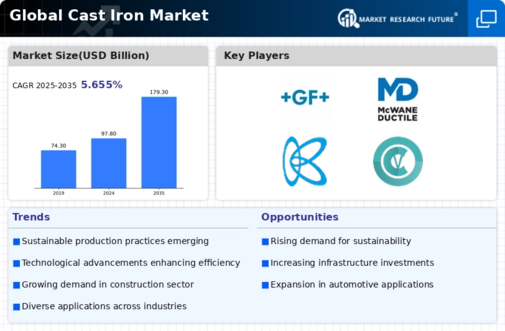Market Growth Projections
The Global Cast Iron Market Industry is poised for substantial growth, with projections indicating a market size of 97.8 USD Billion in 2024 and an anticipated increase to 179.3 USD Billion by 2035. This growth trajectory suggests a compound annual growth rate (CAGR) of 5.66% from 2025 to 2035. Various factors contribute to this optimistic outlook, including rising demand in construction and automotive sectors, technological advancements, and sustainability initiatives. As industries increasingly recognize the benefits of cast iron, the market is likely to expand, presenting opportunities for manufacturers and stakeholders alike.
Rising Automotive Applications
The automotive industry significantly influences the Global Cast Iron Market Industry, as cast iron is extensively utilized in manufacturing engine blocks, brake components, and other critical parts. The material's excellent wear resistance and thermal stability make it a preferred choice among manufacturers. As the automotive sector evolves, particularly with the rise of electric vehicles, the demand for lightweight and efficient materials is likely to increase. This shift may lead to a reevaluation of cast iron's role, but its established presence suggests it will remain integral. The market is expected to grow, with projections indicating a CAGR of 5.66% from 2025 to 2035.
Growing Demand in Construction Sector
The Global Cast Iron Market Industry is experiencing a surge in demand driven by the construction sector. Cast iron is favored for its durability and strength, making it ideal for various applications, including pipes, fittings, and structural components. In 2024, the market is projected to reach 97.8 USD Billion, reflecting the increasing investments in infrastructure development worldwide. Countries are focusing on modernizing their infrastructure, which further propels the demand for cast iron products. This trend indicates a robust growth trajectory for the industry, as the construction sector continues to expand, particularly in emerging economies.
Diverse Applications Across Industries
The versatility of cast iron contributes significantly to the growth of the Global Cast Iron Market Industry. It is utilized across various sectors, including construction, automotive, and consumer goods, due to its unique properties such as high tensile strength and excellent machinability. This diversity allows manufacturers to cater to a wide range of applications, from cookware to heavy machinery components. As industries continue to evolve and expand, the demand for cast iron products is expected to rise. The market's ability to adapt to different applications positions it favorably for sustained growth, with projections indicating a market size of 179.3 USD Billion by 2035.
Sustainability and Recycling Initiatives
Sustainability concerns are becoming increasingly prominent within the Global Cast Iron Market Industry, with a growing emphasis on recycling and eco-friendly practices. Cast iron is highly recyclable, which aligns with global efforts to reduce waste and promote sustainable manufacturing. Many companies are now focusing on utilizing recycled materials in their production processes, which not only conserves resources but also reduces emissions associated with new material extraction. This shift towards sustainability is likely to attract environmentally conscious consumers and businesses, further driving demand for cast iron products. The industry's commitment to sustainability may enhance its reputation and market position.
Technological Advancements in Production
Technological innovations in the production processes of cast iron are enhancing efficiency and reducing costs within the Global Cast Iron Market Industry. Advanced manufacturing techniques, such as 3D printing and automated casting processes, are being adopted to improve product quality and reduce waste. These advancements allow for more precise control over material properties, leading to better performance in applications. As production becomes more streamlined, manufacturers can meet the rising demand while maintaining competitive pricing. This trend is likely to contribute to the overall growth of the market, as companies leverage technology to enhance their offerings.















Leave a Comment